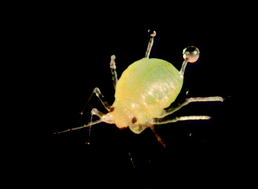Covering: up to the end of 2012
Chemical signalling between aphids (small insects that suck plant sap) for mating and avoidance of antagonistic organisms, and between aphids and plants for location of hosts or avoidance of unsuitable plants, employs minute levels of small lipophilic molecules (SLMs), termed “semiochemicals”. These semiochemicals, which include sex and alarm pheromones, although often involving relatively simple volatile compounds to allow aerial transmission, convey highly accurate information, either through the uniqueness of their chemical structure or by acting together in characteristic mixtures. In addition, by chemical instability, they do not remain in the environment after their essential signalling role has occurred. Aphids, as a consequence of direct feeding or virus transmission, are major pests of agriculture and horticulture. Aphid semiochemicals present novel opportunities for management of pest populations, but problems of synthesis costs and delivery need to be overcome. Genes for associated enzymes in aphids and plants offer solutions, either for production and subsequent deployment in agriculture, or for direct biosynthesis by crop plants as a new generation of genetically modified organisms (GMOs). These approaches are currently under active investigation. Semiochemicals released from plants during aphid feeding can also “switch on” defence chemistry-related genes in intact plants under field conditions, and the gene promoter sequences involved could be used to produce novel types of sentinel plants. The molecular recognition mechanisms employed in aphid olfactory systems are being investigated to provide potential tools for recognition of SLMs, and the acceptance of substrate analogues is explored with enzymes synthesising aphid semiochemicals in an attempt to provide more active or stable structural analogues.


 Please wait while we load your content...
Please wait while we load your content...